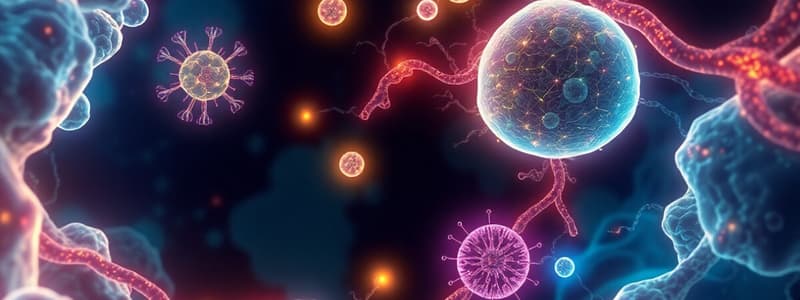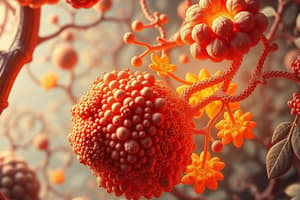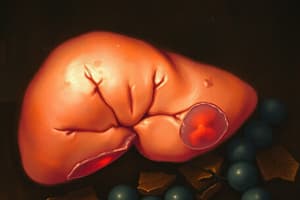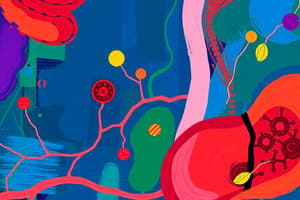Podcast
Questions and Answers
Gluconeogenesis is essential for maintaining blood glucose levels during fasting. What is the primary source of glucose during the initial stages of fasting?
Gluconeogenesis is essential for maintaining blood glucose levels during fasting. What is the primary source of glucose during the initial stages of fasting?
- Breakdown of fatty acids into ketone bodies
- Glycogen stored in the liver (correct)
- Dietary intake of carbohydrates
- Protein synthesis from amino acids
Which of the following non-carbohydrate precursors can be used by the human body to synthesize glucose through gluconeogenesis?
Which of the following non-carbohydrate precursors can be used by the human body to synthesize glucose through gluconeogenesis?
- Ketone bodies
- Glycercol (correct)
- Fatty acids
- Acetyl-CoA
In gluconeogenesis, certain enzymes bypass irreversible steps of glycolysis. Which enzyme used in gluconeogenesis bypasses the action of phosphofructokinase in glycolysis?
In gluconeogenesis, certain enzymes bypass irreversible steps of glycolysis. Which enzyme used in gluconeogenesis bypasses the action of phosphofructokinase in glycolysis?
- Pyruvate carboxylase
- Glucose-6-phosphatase
- Fructose-1,6-bisphosphatase (correct)
- Phosphoenolpyruvate carboxykinase (PEP carboxykinase)
Why is the reciprocal regulation of glycolysis and gluconeogenesis important?
Why is the reciprocal regulation of glycolysis and gluconeogenesis important?
Which enzyme involved in gluconeogenesis is not located in the cytosol?
Which enzyme involved in gluconeogenesis is not located in the cytosol?
During gluconeogenesis, pyruvate is first converted to oxaloacetate. What cofactor is essential for this reaction, which is catalyzed by pyruvate carboxylase?
During gluconeogenesis, pyruvate is first converted to oxaloacetate. What cofactor is essential for this reaction, which is catalyzed by pyruvate carboxylase?
Oxaloacetate, produced in the mitochondria, needs to be transported to the cytosol for gluconeogenesis. How is this achieved?
Oxaloacetate, produced in the mitochondria, needs to be transported to the cytosol for gluconeogenesis. How is this achieved?
Which of the following statements about the regulation of pyruvate carboxylase is correct?
Which of the following statements about the regulation of pyruvate carboxylase is correct?
What is the role of the enzyme glucose-6-phosphatase in gluconeogenesis?
What is the role of the enzyme glucose-6-phosphatase in gluconeogenesis?
Why can't gluconeogenesis occur in muscle tissue?
Why can't gluconeogenesis occur in muscle tissue?
Which of the following describes "phosphorolysis"?
Which of the following describes "phosphorolysis"?
Which statement below accurately describes the digestive breakdown of starch?
Which statement below accurately describes the digestive breakdown of starch?
What is the role of glycogen phosphorylase?
What is the role of glycogen phosphorylase?
In the context of glycogen phosphorylase regulation, which of the following statements is true regarding its activation?
In the context of glycogen phosphorylase regulation, which of the following statements is true regarding its activation?
Under normal conditions, which of the following is a negative heterotropic effector that stabilizes the T-state of glycogen phosphorylase?
Under normal conditions, which of the following is a negative heterotropic effector that stabilizes the T-state of glycogen phosphorylase?
When a cell is in 'fight or flight', what overides everything?
When a cell is in 'fight or flight', what overides everything?
What is the main function of alpha-amylase?
What is the main function of alpha-amylase?
What is the function of debranching enzyme?
What is the function of debranching enzyme?
Where are glycogen stores primarily found in the body?
Where are glycogen stores primarily found in the body?
What type of linkage is created by branching enzyme?
What type of linkage is created by branching enzyme?
What role does insulin play in glycogen metabolism?
What role does insulin play in glycogen metabolism?
What is the effect of cortisol on glycogen metabolism?
What is the effect of cortisol on glycogen metabolism?
What is the primary function of the pentose phosphate pathway?
What is the primary function of the pentose phosphate pathway?
What is the first step of the oxidative phase of the pentose phosphate pathway?
What is the first step of the oxidative phase of the pentose phosphate pathway?
Which of the following molecules is both a product and an inhibitor of glucose-6-phosphate dehydrogenase in the pentose phosphate pathway?
Which of the following molecules is both a product and an inhibitor of glucose-6-phosphate dehydrogenase in the pentose phosphate pathway?
What are the end products of the Overall Net Reaction of the pentose phosphate pathway?
What are the end products of the Overall Net Reaction of the pentose phosphate pathway?
Transketolase and transaldolase are two key enzymes of the pentose phosphate pathway that facilitate the interconversion of sugars. What is the primary function of these enzymes?
Transketolase and transaldolase are two key enzymes of the pentose phosphate pathway that facilitate the interconversion of sugars. What is the primary function of these enzymes?
If a cell requires more NADPH than ribose-5-phosphate, how is the pentose phosphate pathway regulated to meet this demand?
If a cell requires more NADPH than ribose-5-phosphate, how is the pentose phosphate pathway regulated to meet this demand?
Under conditions where both NADPH and ATP are needed but ribose-5-phosphate is not needed, how is the pentose phosphate pathway regulated?
Under conditions where both NADPH and ATP are needed but ribose-5-phosphate is not needed, how is the pentose phosphate pathway regulated?
Why does glucose need to be activated by forming nucleotide sugars?
Why does glucose need to be activated by forming nucleotide sugars?
What type of reaction occurs when synthesizing glycogen?
What type of reaction occurs when synthesizing glycogen?
Glycogenin, which is involved in the function of glycogen synthase, is covalently linked to what?
Glycogenin, which is involved in the function of glycogen synthase, is covalently linked to what?
Flashcards
What is Gluconeogenesis?
What is Gluconeogenesis?
The process of synthesizing new glucose from non-carbohydrate precursors.
Which cells depend on glucose?
Which cells depend on glucose?
Brain and red blood cells rely almost entirely on glucose for energy.
What are Gluconeogenesis precursors?
What are Gluconeogenesis precursors?
Lactate, pyruvate, most amino acids (from protein hydrolysis), and glycerol (from TAG hydrolysis).
What is the Cori Cycle?
What is the Cori Cycle?
Signup and view all the flashcards
Where does Gluconeogenesis occur?
Where does Gluconeogenesis occur?
Signup and view all the flashcards
What are Gluconeogenesis-unique enzymes?
What are Gluconeogenesis-unique enzymes?
Signup and view all the flashcards
Enzymes bypassing pyruvate kinase
Enzymes bypassing pyruvate kinase
Signup and view all the flashcards
Enzyme bypassing phosphofructokinase?
Enzyme bypassing phosphofructokinase?
Signup and view all the flashcards
What does glucose-6-phosphatase do?
What does glucose-6-phosphatase do?
Signup and view all the flashcards
What is the futile cycle of Gluconeogenesis?
What is the futile cycle of Gluconeogenesis?
Signup and view all the flashcards
Which 2 enzymes are involved In Bypass I?
Which 2 enzymes are involved In Bypass I?
Signup and view all the flashcards
What is Pyruvate Carboxylase?
What is Pyruvate Carboxylase?
Signup and view all the flashcards
How does lactate enter gluconeogenesis?
How does lactate enter gluconeogenesis?
Signup and view all the flashcards
What is Phosphoenolpyruvate Carboxykinase?
What is Phosphoenolpyruvate Carboxykinase?
Signup and view all the flashcards
What is Fructose-1,6-Bisphosphatase?
What is Fructose-1,6-Bisphosphatase?
Signup and view all the flashcards
What is Glucose-6-Phosphatase?
What is Glucose-6-Phosphatase?
Signup and view all the flashcards
When is Gluconeogenesis active?
When is Gluconeogenesis active?
Signup and view all the flashcards
Name the main Mechanisms of Regulation?
Name the main Mechanisms of Regulation?
Signup and view all the flashcards
When does Glycolysis signal low energy?
When does Glycolysis signal low energy?
Signup and view all the flashcards
What activates/produces pyruvate?
What activates/produces pyruvate?
Signup and view all the flashcards
What controls Glycolysis?
What controls Glycolysis?
Signup and view all the flashcards
What is Glycogen Phosphorylase?
What is Glycogen Phosphorylase?
Signup and view all the flashcards
How is glycogen phosphorylase regulated?
How is glycogen phosphorylase regulated?
Signup and view all the flashcards
How do effectors stabilize Glycogen Phosphorylase?
How do effectors stabilize Glycogen Phosphorylase?
Signup and view all the flashcards
What occurs in fight or flight?
What occurs in fight or flight?
Signup and view all the flashcards
What does glycogen Synthase do?
What does glycogen Synthase do?
Signup and view all the flashcards
What activates glucose by formation of nucleotide sugars?
What activates glucose by formation of nucleotide sugars?
Signup and view all the flashcards
What adds to glycogen?
What adds to glycogen?
Signup and view all the flashcards
Stimulators and inhibitors of glycogen
Stimulators and inhibitors of glycogen
Signup and view all the flashcards
What is NADPH used for?
What is NADPH used for?
Signup and view all the flashcards
What is the Pentose Phosphate Pathway?
What is the Pentose Phosphate Pathway?
Signup and view all the flashcards
What does the Pentose Phosphate Pathway consist of?
What does the Pentose Phosphate Pathway consist of?
Signup and view all the flashcards
Enzyme to make ATP and NADPH enter?
Enzyme to make ATP and NADPH enter?
Signup and view all the flashcards
Study Notes
- Gluconeogenesis is "making new glucose".
Dependence on Glucose
- Cells rely on glucose for energy.
- Brain and red blood cells are almost entirely dependent on glucose.
- Liver-stored glycogen can supply the brain with glucose for only 1½ days when fasting.
- If the body cannot obtain glucose from diet, it produces it from non-carbohydrate precursors.
What Gluconeogenesis Is
- Gluconeogenesis is "the generation of new sugar."
- New glucose is synthesized from lactate, pyruvate, most amino acids through protein hydrolysis, and glycerol through TAG hydrolysis.
- Animals cannot use acetyl CoA to synthesize glucose.
- Plants use the glyoxalate cycle with acetyl CoA to make glucose.
- Gluconeogenesis occurs in the liver (90%) and kidneys (10%).
- Microorganisms use acetate and propionate as gluconeogenesis substrates.
Cori Cycle
- Lactate and pyruvate are essential within the Cori Cycle
How Glycolysis & Gluconeogenesis Relate
- Gluconeogenesis and glycolysis are opposing metabolic pathways with three differences:
- Pyruvate kinase is bypassed by pyruvate carboxylase & PEP carboxykinase.
- Phosphofructokinase is bypassed by fructose-1,6-bisphosphatase.
- Hexokinase is bypassed by glucose-6-phosphatase.
- Glycolysis Net Reaction: Glucose + 2 NAD+ + 2 ADP + 2 Pi → 2 Pyruvate + 2 NADH + 2 H+ + 2 ATP + 2 H2O
- Gluconeogenesis Net Reaction: 2 Pyruvate + 2 NADH + 2 H+ + 4 ATP + 2 GTP + 6 H2O → Glucose + 2 NAD+ + 4 ADP + 2 GDP + 6 Pi
- Adding both net reactions together: 2 ATP + 2 GTP + 4 H2O → 2 ADP + 2 GDP + 4 Pi
- Gluconeogenesis tightly regulated, wasteful cycle.
- Gluconeogenesis enzymes are in the cytosol, except glucose-6-phosphatase, which is in the ER, and pyruvate carboxylase, which is in the mitochondria.
Unique Reactions of Gluconeogenesis
- Bypass I: Pyruvate → Oxaloacetate → Phosphoenolpyruvate; replacing pyruvate kinase.
- Pyruvate Carboxylase – Carboxylation happens in the mitochondrial matrix.
- The reaction is: Pyruvate + HCO3- + ATP → Oxaloacetate + ADP + Pi
- Acetyl CoA activates
- Cofactor is Biotin
- Oxaloacetate is too polar to cross mitochondrial membranes, so it is converted to aspartate or malate for transport.
- Phosphoenolpyruvate Carboxykinase - Decarboxylation
- Occurs in the cytosol.
- Oxaloacetate, a 'high energy' intermediate, allows for the exergonic decarboxylation needed to form PEP.
- Beta-ketoacids are 'high energy' intermediates because the loss of CO2 generates a strong enolate.
- Pyruvate carboxylase is a biotin-dependent enzyme.
- Bicarbonate must be activated for attack by the pyruvate carbanion, driven by ATP.
- Bypass II: Fructose 1,6-Bisphosphate → Fructose 6-Phosphate
- Replaces phosphofructokinase
- Fructose 1,6-Bisphosphatase - Phosphoester hydrolysis
- Occurs in cytosol.
- Bypass III: Glucose 6-Phosphate → Glucose
- Replaces hexokinase
- Glucose 6-Phosphatase - Phosphoester hydrolysis
- Occurs in ER
- The enzyme is not found in muscle or brain, meaning gluconeogenesis cannot occur in these organs.
- Glucose is exported from the ER into the bloodstream, going to the brain to carry out glycolysis.
How Gluconeogenesis is Regulated
- Reciprocal Control of Glycolysis & Gluconeogenesis.
- Glycolysis is ON when the cell needs ATP & NADH.
- Gluconeogenesis is ON when the cell does not need ATP & NADH and there is excess lactate/pyruvate, and the cell wants to store glucose as glycogen.
- Mechanisms of regulations:
- Substrate-level control of Gluocose-6-phosphatase occurs.
- Allosteric regulation via Fructose-2,6,-Bisphosphate & Acetyl CoA occurs.
- Covalent modification, phosphorylation/dephosphorylation, via cAMP allows for hormonal control.
- Transcriptional control of the gene encoding PEP carboxykinase occurs.
- Phosphorylation inhibits gluconeogenesis and stimulates glycolysis.
Glycogen
- Body obtains glucose from storage or dies
- Glycogen is mostly stored in the liver and muscles.
- The structure is optimized to store and deliver energy quickly and for the longest time.
- Key for optimization is average branch chain length of 13 residues
Glycogen & Starch Catabolism
- Alpha-Amylase is an endoglycosidase α(1->4).
- It is active on either side of a branch point, but its activity is reduced near branch points.
- Debranching enzyme cleaves "limit dextrins" and has two activities:
- Transferring trisaccharide groups.
- Cleaving remaining single glucose units from the main chain α(1->6).
Tissue Glycogen Metabolism Regulation
- Digestive breakdown of starch is unregulated - nearly 100% of ingested food is absorbed and metabolized.
- Tissue glycogen is a breakdown that is carefully controlled with high MW "granules" and it its important for energy
- Glycogen phosphorylase cleaves glucose from the nonreducing ends of glycogen molecules with phosphate as nucleophile in a "phosphorolysis", not a hydrolysis
- Product is a sugar-P - a potential glycolysis substrate.
Glycogen Catabolism
- Glycogen Phosphorylase
- It liberates glucose units from stored glycogen reserves in muscles & liver when energy is needed
- Tightly regulated via allosteric regulation & covalent modification, it is paradigm of enzyme regulation
- It is activated when cell needs energy and inactivated when cells at rest (store glucose as glycogen)
- Catalytic Reaction
- This Cleaves glucose units from non reducing ends of glycogen Phophorolysis not hydrolysis for glucose-1-phosphate product
Glycogen Phosphorylase Regulation
- Allosteric Effectors follow a meets normal metabolic needs , under normal conditions as positive homotropic effector: Pi Negative heterotropic effectors: ATP & glucose-6-P and positive heterotropic effector: AMP
- Covalent Modification emergency situation
- occurs in "fight or flight" situations and covalent modification overrides everything
- more active phosphorylase a phosphorylation of Ser-14
- hormone-activated signal cascade (glucagon & epinephrine)
Glycogen Synthesis
- Higher animals store excess glucose as glycogen
- Glycogen phosphorylase (Glycogen → Glucose) Vs glycogen synthase (Glu → Gly)
- Activation of glucose by formation of nucleotide sugars
- Sugar Nucleotides activated forms of sugar units
- UDP-glucose – donor for glycogen biosynthesis
- Nucleotide labels mark sugar
- ADP-glucose – donor for starch biosynthesis
- UDP-glucose Pyrophosphorylase
- Reaction is driven by PPi hydrolysis
- Only one phosphoanhydride bond is consumed in the storage of one glucose in glycogen. Upon glycogen degradation, one glucose yields 32 ATP
Glycogen Synthesis (Continued)
- Synthesis of glycogen via glycogen synthase and branch enzyme: UDP-Glucose + (Glucose)n → UDP + (Glu)n+1
- Glucose is added to the non-reducing ends of glycogen by glycogen synthase.
- Glycogenin, a protein, is covalently linked to the first glucose via an acetal linkage to Tyr-OH.
- α (1→6) branches every 8-12 residues generate more non-reducing ends.
Glycogen Metabolism Control
- Hormones regulate glycogen metabolism & blood glucose levels
- Insulin (lowers blood glucose) and Glucagon (raises) maintain blood glucose levels around 4.5 mM.
- Glycogen breakdown is triggered by glucagon & epinephrine
- Glycogen biosynthesis by insulin
- Cortisol & Glucocorticoid cause long-term stress hormones that affects liver, skeletal muscle and adipose tissues
- Promotes protein breakdown & decreases protein synthesis.
- Stimulates gluconeogenesis & Glycogen synthesis (transcriptional control).
Glucose Provide Electrons for Biosynthesis
- Cells are provided with a constant supply of NADPH for biosynthesis by the pentose phosphate pathway
- This pathway produces ribose-5-Pathway for RNA
- It operates mostly in cytosol of liver and adipose cells
- It uses NADPH for fatty acid
Electron Biosynthesis
- Pentose phosphate pathway operates in liver & adipose tissue.
- Generates NADPH (reducing power) & ribose-5-phosphate
- ATP is the cell's "energy" currency. NADPH is used to drive endergonic reductive biosynthesis.
- Pentose phosphate pathway is an alternative pathway to glycolysis.
- Overall Net Reaction: 3 Glucose-6-P + 6 NADP+ + 3 H2O ⇔ 6 NADPH + 6 H+ + 3 CO2 + 2 Fructose-6-P + Glyceraldehyde-3-P
- Three Stages of Pentose Phosphate Pathway:
- Oxidative Rxns: Rxns 1 – 3: NADPH production: 3 Glucose-6-P + 6 NADP+ + 3 H2O → 6 NADPH + 6 H+ + 3 CO2 + Ribulose-5-P
- Isomerization & Epimerization Rxns: Rxns 4 & 5: Ribose-5-P is for nucleic acid biosynthesis: 3 Ribulose-5-P ⇔ Ribose-5-P + 2 Xylulose-5-P
- C–C Bond Cleavage & Formation Rxns: Rxns 6 – 8: Fructose-6-P & Glyceraldehyde-3-P is for glycolysis: Ribose-5-P + 2 Xylulose-5-P ⇔ 2 Fructose-6-P + Glyceraldehyde-3-P
Oxidative Reactions
- Glucose-6-Phosphate Dehydrogenase yields NADPH & cyclic ester
- Irreversible 1st step & highly regulated. Inhibited by product NADPH
- Gluconolactonase (hydrolysis) and 6-Phosphogluconate Dehydrogenase.
- Product Ru5P must be converted to R5P or Xu5P for further use
Isomerization & Epimerization Rxns
- Phosphopentose Isomerase, Enediol intermediate
- Product R5P used in nucleic acid biosynthesis (NADH, NADPH, FAD & B12)
- Phosphopentose Epimerase (Proton Transfer) with Enediol intermediate and inversion of -OH group
Reactions for C–C Bond Cleavage & Formation
- Ketolase and Transaldolase are involved
- Transketolase
- Two carbon transfer from ketose to aldose
- Transaldolase that converst sedohepatulose-7-P using products for glycolysis
- Three carbon transfer from ketose to aldose
- Transketolase
Pentose Phosphate Pathway
- Glucose-6-Phosphate is a crucial branch point in glycolysis & pentose phosphate pathway
- Its production controls production controlled at 1st step through glucose-6-phosphate dehydrogenase
- Make ATP by having glucose-6-P enter glycolysis or NADPH for by having glucose-6-P enter pentose phosphate pathway.
- Four Possibilities for Pentose Phosphate Pathway:
- Both ribose-5-phosphate & NADPH if needed
- More ribose-5-phosphate than NADPH if needed through bypassing oxidation reactions
- More NADPH than ribose-5-phosphate if needed through recycling R5P to become glycolytic
- Both NADPH & ATP are needed if ribose-5-phosphate is not needed and converts to pyruvate
Studying That Suits You
Use AI to generate personalized quizzes and flashcards to suit your learning preferences.




